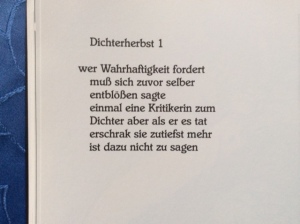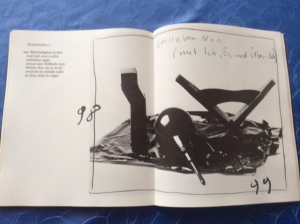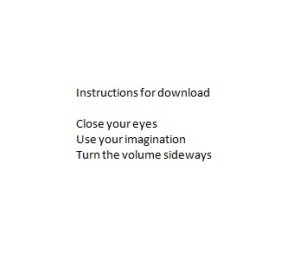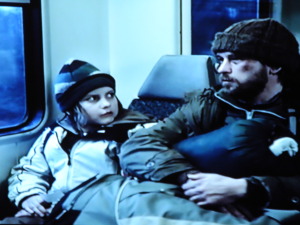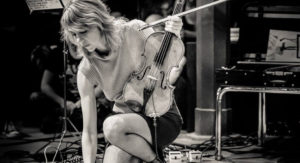Henning has seen Fredrik once, Henning has met Lajla here and there, Michael in Kristiansand three years in a row, and no one else. Gregor has met Michael several times, he knows Wolfram, and he has seen no one else. Martina has seen Michael once, on a concert in Frankfurt, and she has met no one else. Ian has met no one yet. Jochen has met no one yet. Markus and Jan have met no one yet. Lajla has met Michael and no one else. Fredrik has seen Michael and Henning at Punkt, and no one else. Uwe met Michael a few times and no one else. That’s normal, Michael has been the „headhunter“ here, and Jochen is the webmaster in the background. Jochen has seen no one yet. Though Michael and Jochen are talking on the phone on a regular basis. We’re strangers, we’re friends. Is it not wonderful to make Manafonistas such a living organism where you’re not limited to a certain kind of writing, where you’re free to write anything you want and find appropriate (risk-taking is appropriate, too)!? The autobiographical and the purely invented – generator of ideas, deep music writing and thriller reviews, travel notes and memories, fantasies and one-picture stories by special guests. Though there are controversial thoughts, there is a kind of soulmateship, too. You know what I mean even if soulmateship might not be a correct English word. And we’re all anti-fundamentalists! Einer für alle, alle für einen! That may be the only „fundamental rule“ here. The idea of Manafonistas is a strange mix of Alexandre Dumas and Italo Calvino, idea-wise. The adventurous and the fragmented. And Julio Cortazar would have been the archetypal Manafonista! There will never be more than twelve, that’s the rule. I think (more and more) we shouldn’t turn this into a final game a la Beckett or „Last (Wo)Man Standing“ meaning that in the end the last survivor will be writing last stories, last notes, last words. It might be better to stay a „dirty dozen“. One quits, another one comes. Well, this last open question will be decided on the first meeting of the Manafonistas on Sylt, next year!
Archives: September 2014
2014 17 Sep.
Wanna take a short glimpse into Robert Wyatt’s Different Every Time book ?
Uwe Meilchen | Filed under: Blog | RSS 2.0 | TB | 2 Comments
… Amazingly, there’s already the opportunity to have a short look into the Robert Wyatt biography and to get an idea what is in store for the interested reader !
2014 16 Sep.
Meeting at Punkt 2014 (Remix)
Fredrik Hossmann | Filed under: Blog | RSS 2.0 | TB | Tags: Arve Anderson, Fennez4, Helikh Onore, Jana Harding. Mike Winderen, Laurie Henriksen, Michael Engelbrecht, Punkt, Punkt 2014, remix, Sheriffjunko, Sheriffs of nothingness, Streifen of Nothingness, Streifenjunko | 2 Comments
Thursday
We met where the stairs ended, waiting for the first begin to concert. Exchanging some walls while the words we spoke slowly turned into a bridge between us. After a while, he said his name: Fredrik Engelbrecht and I said mine: Michael Hossmann.
The first concert changing something inside of me was Sheriffjunko + Streifen of Nothingness. Playing without microphones, but inside them was the sampling of experience, delays, sound manipulations and technology all brought back to their Viofones, saxpet and trumlin. Did i listen with open or closed eyes? I don’t remember. It is not important. Was i on the stage? Were the musicians inside of me? New roles are needed to describe these feelings: like perdience and auformer.
Me and him meeting between the concerts – discussing among other topics music not yet created. What is the sound of Neil Davis and Miles Young? Of Bob Eno and Brian Dylan? Of Leonard Brahem and Anouar Cohen?
Friday
began with the Radioshow: Burning songs for storytellers (or how to turn magic into radio.) filled with songs that were mine before I had even heard them. Followed by the almost brutal soundscapes of Jana Harding and Mike Vinderen. A voyage into the depths of their uncompromising recordings of unspoken promises from the independent recording business played back at earsplitting volume. It was painfully pleasant closing the eyes and floating away into the unending space between my ears. At last there was a meeting with Andy Laurel, who spoke a lot about her cat slowly growing deaf, but had learned to play cards. We would watch a movie with the cat playing poker and grinning. The image of this almost deaf cat with a paw full of a straight flush is a door that I have passed and can never go back.
Later that evening Eriographs by Helikh Onore was a fishbowl of aural delight and we were flying with the seagulls on the beach. Arve Zach and Eivind Henriksen on drumtar and gitpet. Jeffrey Aarseth and Ingar Bruinsma on viobal and cymlin. And the remix, just flowing out of the moment, like a gracious dolphin giving birth to itself under water. Another of these magic moments was to see a Zapp played by his instrument, to see a machine touch his naked skin, to hear sounds that no Bang has yet wrenched from the bottom of his endlessly moving body. There was hammers of sound and nails of noise. And then the remix by Fennesz4; violently playful and playfully violent at the same time, a contrast between before and after the beginning.
Saturday
began with Henning Bang seducing Jan Bolte about his sampled approach to conversational Zapping.
This is where the idea of remixing conversations came up:
What tools does the conversation remixer have? A sampler – repeating everything that is said. A cutup sampler – sampup a cutler. Playing samples backwards. Sdrawkcab selpmas gniyalp. Adding delay. Repeating the words slower (sssllloooowwwwweeeerrrr) or faster (fstr) or making them stutter. We have the replacer and the sensotron – taking everything that is send and depending on which direction you push the dial too make sense out of random or the purest stupidity out of perfectly sensibel krauersaut.
The discussion ended with a poem sampled and remixed live:
„Why not sit on the wind / bang on a drop of water / and sing along with the rocks …“
Then there was an unnamed piece outside of the official program performed by a nameless artist with an ending I wished had continued longer, a beginning that had begun later and a middle that could have been somewhere else. Later that evening the concert with Bang4 and Jan Zapp was not without reason that the applause were rising to the feet after this audience. A cascade of beings responding to each other picking up elements letting go returning floating mirroring breaking glass red velvet getting lost finding the way being the way just being (…) Closing in to the end we gathered in the belly of the Phoenix to listen to Arve Anderson on trumlin and Laurie Henriksen on violet blending into each other becoming one beautiful beast. The final words softly spoken were:
„The stars looking down on us / too far away / far away to touch / still they try / still they try to touch us / with their fingers / fingers of light / light / fading light“
*
Here are some tracks you can download for your listening pleasure:
Arve Anderson and Laura Henriksen – The Birth of the Phoenix
Bang4 and Jan Zapp – (Videofeet Remix)
Unnamed artist: unnamed piece – Silent remix by Fredael Engelmann
Henning Bang/Jan Bolte: interviewing the interviewer Jan Bolte (Recording)
Michrik Hossbrecht – Radioshow: Burning songs for storytellers (or how to turn magic into radio.)
Sheriffjunko + Streifen of Nothingness (Identity blur remix)
Jana Harding and Mike Winderen – The sound of unspoken promises amplified
Eriographs by Helikh Onore (Under water remix)
The remix of Fennez4 (Remix by the remixer remixing the remixers remix)
(to be linked to the picture: instructions for download)
2014 16 Sep.
Killing Ten Little Italians
Lajla Nizinski | Filed under: Blog | RSS 2.0 | TB | 3 Comments
In Pescara I asked somebody to show me the way to the house of Gabriele d’Annunzio.
„Straight straight and then left.“
I went straight straight and turned left: nothing.
1. Sorry, the First has to go away.
I ordered a Pizza with vegetables. They delivered a Pizza with 3 pieces of Würstl and onions on it.
I asked, where are the vegetables?
„The onions!“
2. It’s clear, Nr. 9 has also to disappear.
Then I wanted to take a Bus from Pescara to Termoli. Asked from where does the Bus leave?
„From here, at 11 o’clock.“
No Bus at 11, no busses at all.
I took à train.
3. Clear out!
In the port of Termoli I could only nix à oneway Ticket to the Tremiti Islands. „But how can I Return then?“
„Take à ferry!“
4. Wanted to throw him into the sea.
Finally arrived on San Domino, found à nice little house, asked the landlady for a hot water boiler. She brought me à cup with hot water.
5. Pleazzzzze remove her!
I am à Fan of the italian Singer Lucio Dalla. I know that he lived here. He died 2012. I asked an old man, where did Lucio exactly lived? The man pointed to the other Island: „Behind the Church.“
6. To be omitted!
Anyways I thought I might take à short boattrip to San Nicola to have à look at the wonderful old monastry. I asked à ferryman to bring me over. I had to wait two hours for à five minute trip.
7. Anotherone just gone.
On that island is à little Radio Museum. The Lady in the entrance told me that I have to take the elevator. I said that I wanted to Walk. She said: „take the elevator“
i just walked away.
8. Please Carry her away.
Only two Little Italians left.
„Where does the name TREMITI come from? What does it mean?“
-Three mountains
-Three winds
-Three Diomedes
Gosh! There is only One Diomedes, Heroe of the Trojans.
9. So only One leftover.
I’m always interested in the original Music of one place.
I asked: „What Kind of Music did People play here on the Islands?“
„Disco Music.“
10. I can’t throw all of them into the Adriatic, can I?
2014 16 Sep.
Here he comes (very soon), the 12th Manafonista
Manafonistas | Filed under: Blog | RSS 2.0 | TB | Comments off
„Here he comes the boy who tried to vanish to the future or the past / Is no longer alone among the dragonflies / Here he comes here he comes“ (Brian Eno, Here He Comes)
„We met where the stairs ended, waiting for the first begin to concert. Exchanging some walls while the words we spoke slowly turned into a bridge between us. After a while, he said his name: Fredrik Engelbrecht and I said mine: Michael Hossmann.“
As you might now already have realized, the first post will be a remix, a remix of special moments of the 10th Punktfestival in Kristiansand.
2014 15 Sep.
Leonard Cohen: Popular Problems (a very short review)
Michael Engelbrecht | Filed under: Blog | RSS 2.0 | TB | 4 Comments
You can go into the details, and if you’ve followed Leonard’s way, you’ll do it anyway. 80 years old, the man from Canada is about to release a very good album. Three „killers“, no fillers. Decent songs, the other ones, at least. Decent in the best way, blues-inflected, sparse arrangements, the female choir moments well-dosed & never overpowering, short glimpses of an Arabic-sounding voice, deep breathing, darkness with humour mixed in his own peculiar way. The titles of the outstanding tracks: „Almost Like The Blues“, „The Street“, and, best of all, brilliantly set in scene, „Nevermind“. Excerpt of „Nevermind’s“ lyrics: „Your victory was so complete / Some among you thought to keep / A record of our little lives / The clothes we wore, our spoons, our knives / The games of luck our soldiers played / The stones we cut / The songs we made / Our law of peace, which understands / A husband leads, a wife commands … / Names so deep and names so true / They’re blood to me and dust to you.“ You will go into the details, angels and demons included.
2014 15 Sep.
Der nächste oder übernächste oder soundsovielte schlechte Witz seit der herzlichen Begegnung des Papstes mit Fifa-Boss Blatter, oder: Von Ethikkommissionen und Parmigiani-Luxusuhren
Michael Engelbrecht | Filed under: Blog | RSS 2.0 | TB | 3 Comments
Unfassbar: heute in der SZ ein Artikel im Sportteil der Süddeutschen Zeitung. Von wem sonst als dem Sportjournalisten Thomas Kistner, dessen Bücher allesamt das Prädikat „besonders entlarvend“ verdienen. Der Artikel findet sich auf Seite 32 unten rechts, und wird hier, sobald er als „link“ verfügbar ist, angegeben. „Ganz unten in der Tüte. Eine neue Affäre im Reich der Fifa: diesmal geht es um Luxusuhren für alle ihre Vorständler“. Szenenwechsel. Als BVB-Fan war für mich natürlich das geglückte Comeback von Shinji Kagawa die reine Freude. Jochens und Gregors Hannover 96 hat sich erstmal auf Platz 3 eingenistet, Gladbach hat mit durchaus begrenzten Möglichkeiten eine beeindruckende Mannschaft zusammengestellt, Paderborn und Köln schlagen sich wacker. Es gibt also noch gute Nachrichten und Überraschungen in diesem universalen Fussballgebilde, das nach wie vor, wie der Fisch, am Kopf am meisten stinkt.
2014 14 Sep.
Locke – ein paar Anmerkungen zu einem Meisterwerk
Michael Engelbrecht | Filed under: Blog | RSS 2.0 | TB | Comments off
1
Wie etwa GRAVITY, ist LOCKE ein Raumfilm, wenn man so will, eine Art „space movie“, obwohl der Raum in Ivan Lockes Welt (Tom Hardy legte sich für den Film einen walisischen Akzent zu, der allein in mehrfacher Hinsicht dieses Drama bereichert) ein sehr begrenzter ist. Er fährt mit seinem Auto von Birmingham nach London, durch die Nacht. Und wie ALL IS LOST, handelt der Film von einem Mann allein, der ums Überleben kämpft, zumindest um das Überleben seiner privaten und sozialen Welt. Und es geht um Würde, ein fürchterlich altbackenes Wort, aber so ist es, es geht um die Erfüllung einer Verpflichtung. „I’ve made a decision“, ist ein Kernsatz. An einer Stelle formuliert Tom Hardy, der diese Rolle mit allen Nuancen ausreizt, ohne je eine Spur zu dick aufzutragen, all seine Vorhaben wie eine Shakespeare’sche Figur in einem Monolog, in grosser, zugeich, an den Rändern der Stimme, zitternden Ruhe, und beendet seine Affirmationen mit dem Satz „… and this is my prayer.“ Gänsehaut pur. Mit Religion hat der Film rein gar nichts am Hut. Anders als Robert Redford in ALL IS LOST, kämpft Ivan Locke nicht mit Naturgewalten, sondern mit den gewaltigen Kräften der menschlichen Natur, und diese können brutal sein, in all ihrem Beharren, Sehnen, und Zerbrechen.
2
Tom Hardys Darbietung ist ja nicht das einzige Highlight des Meisterwerkes “Locke”. Ich habe den Film jetzt zum zweiten Mal gesehen, ohne dass er an Intensität eingebüsst hat. Bei Filmen achte ich stets auf die Musik, und ich habe meine Zweifel, ob der mittlerweile downloadbare Soundtrack auch autonom funktioniert. Und das ist beileibe keine Kritik an der Instrumentalmusik von Dickon Hinchcliffe. Bei einem anderen exzellenten Thriller der letzten Jahre, “Prisoners”, war die Musik des Isländers Johan Johansson eine subtile Bereicherung der erzählten Geschichte, aber als eigenständige Musik schlicht langweilig. Nun arbeitet Dickon Hinchcliffe in “Locke” weitaus mehr mit rhythmischen Elementen als der Isländer im besagtem Film von Regisseur Dennis Villeneuve (dessen danach fabriziertes Machwerk übrigens vollkommener, postkafkaesker Unsinn war). Hinchcliffes Musik sorgt weitgehend für Atempausen, für akustische Zwischenspiele, in diesem gnadenlosen, Kilometer fressenden, Adrenalinrausch. Hinchcliffe gelingt es, Momente der Entspannung und des – kontrapunktisch – “sanften” Schreckens so feinnervig zu verweben, dass der Zuschauer sich, in all diesen Interludien, in denen kein Handy klingelt, keine Menschen durchdrehen, keine Lebensentwürfe kollabieren, einfach mal in die Musik fallen lassen kann.
2014 14 Sep.
Auf dem Zettel stand: Keine Angst
Martina Weber | Filed under: Blog | RSS 2.0 | TB | Tags: Hans Weingartner: Die Summe meiner einzelnen Teile (Kino) | 1 Comment
Denken Sie an einen Menschen, mit dem Sie sich gut verstehen. Wie viel Zeit könnten Sie mit ihm verbringen, ohne sich in sinnvollen Sätzen zu verständigen? Zwei Tage? Zwei Monate? Ein halbes Jahr? Stellen Sie sich vor, dieser Mensch spräche nur Russisch. (Ich nehme an, Sie können kein Russisch.) Wie verändert sich die Versuchsanordnung jetzt? Und wenn es ein Kind ist? Und wenn Sie es sind, wie Sie im Alter von zehn Jahren waren? Haben wir schon über das innere Kind gesprochen? Da verliert ein hochintelligenter Mensch, der an der Übererfüllung der fachlichen Anforderungen zugrunde geht, seinen Job, seine Freundin und seine Wohnung, er versucht in einem Abbruchhaus zu schlafen und plötzlich taucht dieser Junge auf und wird sein Freund. Ist es nicht gleichgültig, ob etwas existiert oder nicht, solange jemand es so erlebt, dass es existiert? Die Grenze zum Wahnsinn? Zum weißen Rauschen? Zur Produktion von Kunst? Zeitschleifen. Streit mit dem Vater. Der Regen prasselt auf die Plastikplane. Die Plane sinkt auf der Erde zusammen. Geruch des Ausgeliefertseins. Ein weggeworfener und wieder zurückgebrachter Liebesbrief. Der Blick in den Himmel über dem Wald und über der Autobahn Richtung Süden. Wo leben wir?
2014 14 Sep.
Samstagnacht in den Klanghorizonten
Manafonistas | Filed under: Blog | RSS 2.0 | TB | Comments off
Die Musik, sagt sie, war „wie ein Tagebuch„, und jede Seite bringe neue Reflexionen und Resonanzen. Sie arbeitete mit dem Produzenten John Parish zusammen, der verschiedene Instrumente auf dem Album spielte, darunter die Gitarre bei ihrer Hommage an Brian Eno, die schlicht „Eno“ heisse. Graindorge hatte John ihr erstes Album geschickt, und sie schlossen eine Freundschaft, die dazu führte, dass sie den größten Teil von „Eldorado“ in seinem Studio aufnahm. Künstlerisch gesehen eine perfekte Ergänzung. „Ich habe gerne mit ihm gearbeitet“, erklärt Catherine Graindorge. „Er ist nicht nur ein exzellenter Musiker, sondern ich liebe auch seine Beziehung zu Klang und Musik: er ist neugierig, immer auf der Suche nach Klängen, und seine raue und direkte Herangehensweise an die Musik hat mir gefallen.“
from TheArtsDesk: „The Eno homage placed at the end is the only composition that hints at some kind of peace and resolution, a welcome and heart-stirring close to an album, that floats heavily in a miasma of blues, greys, and blacks.“
